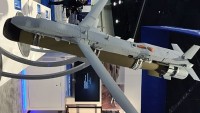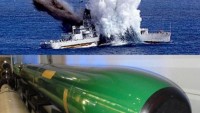Russia's Replacement for Failed ‘Shkval Supercavitating Torpedo’ will Likely be a Failure, Too
| Arthur Dominic Villasanta | | Mar 30, 2017 06:45 PM EDT |
(Photo : Russian Navy) Russia's Shkval supercavitating torpedo.
Russia has gone ahead with its plans to produce a new "supercavitating torpedo" despite five decades of history proving the technology behind this torpedo doesn't work as advertised.
Russia's attraction to a torpedo technology even the U.S. Navy has avoided developing is based mostly on bragging rights. It's only supercavitating torpedo -- the VA-111 Shkval ("Squall") -- can allegedly reach underwater speeds in excess of 200 knots (370 km/h), making it by far the fastest torpedo in the world.
Like Us on Facebook
In comparison, the Mark 48 Advanced Capability heavyweight torpedo, has a top speed of only 55 knots (102 km/h). The Mark 48 is the fastest U.S. Navy torpedo currently in operational use.
The secret to the Shkval's amazing speed is its design. It's basically a rocket powered underwater missile powered by a rocket motor.
Exhaust gases emitted by this rocket engine are vented to the nose of the missile instead of to the rear as is traditional in air breathing rockets.
These extremely hot exhaust gases vaporize water in front of the torpedo and create a mass of high pressure air bubbles around the torpedo. The result is the Shkval "flies" through an underwater pocket of air unimpeded by friction and water resistance.
Missile-like speed, however, is the Shkval's only redeeming feature. Most everything else about this torpedo disqualifies it for widespread use in submarines and surface warships.
The Shkval's chief disadvantages are it's too noisy and it can't be guided. The former drawback means the submarine or warship firing a Shkval instantly gives away its position to its victim, allowing the latter to take countermeasures.
The latter means Shkval can't be equipped with devices that home in on its target since the high pressure air bubbles impede any guidance system. In essence, Shkval is a massive 2,700 kg bullet that can only travel in a straight line.
Shkval was originally designed in the 1960s and entered service with the Soviet Union's navy in 1978. Only Russia and Iran field supercavitating torpedoes. The Iranian version named "Hoot" is a reverse engineered version of the Shkval.
Shkval can deliver its 210 kg high explosive warhead out to a maximum range of 6,900 meters. The U.S. Navy's Mark 48 is armed with a 290 kg warhead it can deploy to a range in excess of 8,000 meters.
In October 2016, Russia announced that Shkval will be replaced by a new supercavitating torpedo called Khishchnik ("Predator").
Not much information has been revealed about Khishchnik other than this torpedo is being designed by the Elektropribor design bureau, which specializes in aviation technology.
TagsRussia, VA-111 Shkval ("Squall"), supercavitating torpedo, Mark 48 Advanced Capability heavyweight torpedo, U.S. Navy, Khishchnik ("Predator")
©2015 Chinatopix All rights reserved. Do not reproduce without permission
EDITOR'S PICKS
-

Did the Trump administration just announce plans for a trade war with ‘hostile’ China and Russia?
-

US Senate passes Taiwan travel bill slammed by China
-

As Yan Sihong’s family grieves, here are other Chinese students who went missing abroad. Some have never been found
-

Beijing blasts Western critics who ‘smear China’ with the term sharp power
-

China Envoy Seeks to Defuse Tensions With U.S. as a Trade War Brews
-

Singapore's Deputy PM Provides Bitcoin Vote of Confidence Amid China's Blanket Bans
-

China warns investors over risks in overseas virtual currency trading
-

Chinese government most trustworthy: survey
-

Kashima Antlers On Course For Back-To-Back Titles
MOST POPULAR
LATEST NEWS
Zhou Yongkang: China's Former Security Chief Sentenced to Life in Prison

China's former Chief of the Ministry of Public Security, Zhou Yongkang, has been given a life sentence after he was found guilty of abusing his office, bribery and deliberately ... Full Article
TRENDING STORY

China Pork Prices Expected to Stabilize As The Supplies Recover

Elephone P9000 Smartphone is now on Sale on Amazon India

There's a Big Chance Cliffhangers Won't Still Be Resolved When Grey's Anatomy Season 13 Returns

Supreme Court Ruled on Samsung vs Apple Dispute for Patent Infringement

Microsoft Surface Pro 5 Rumors and Release Date: What is the Latest?













